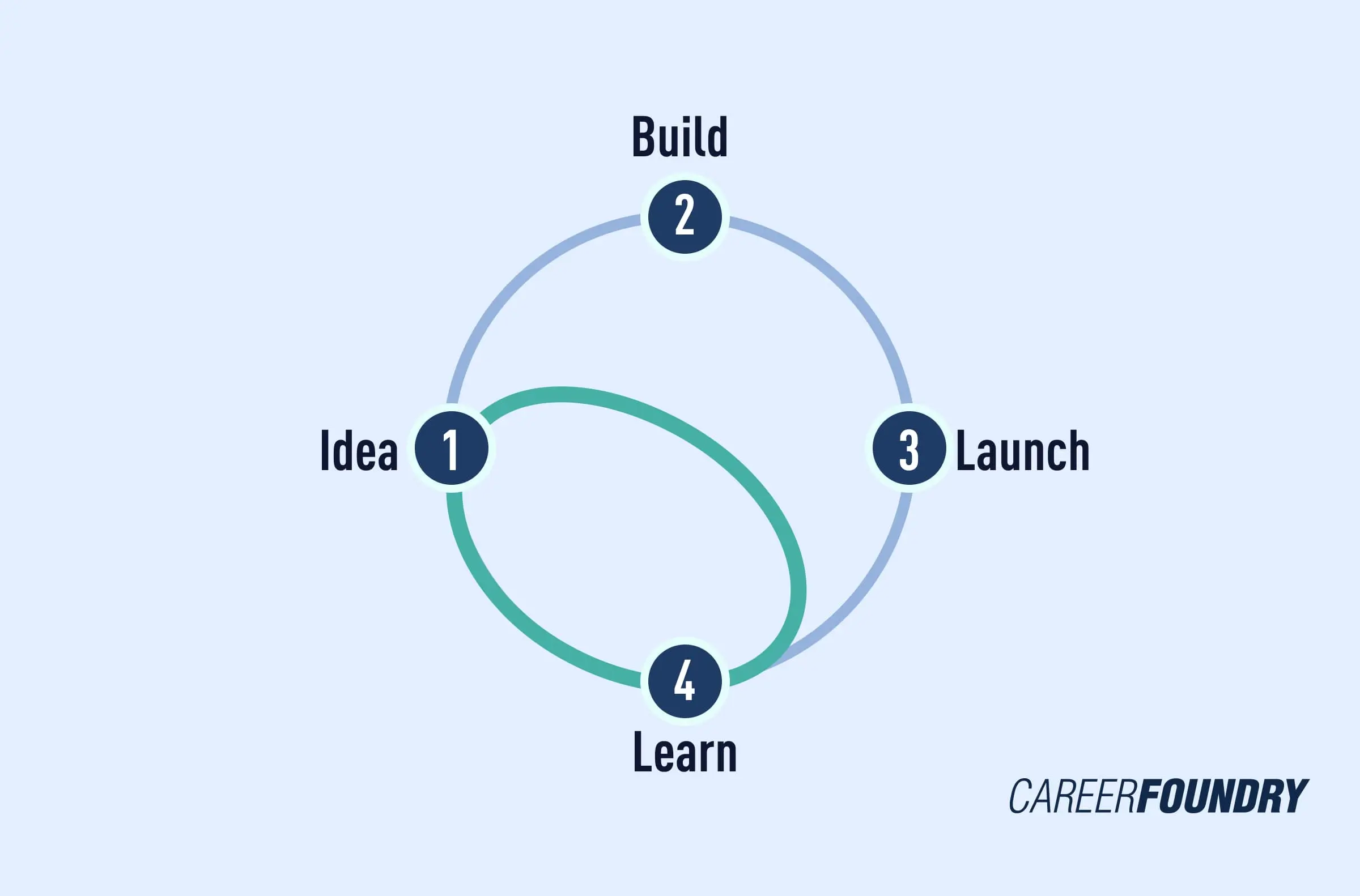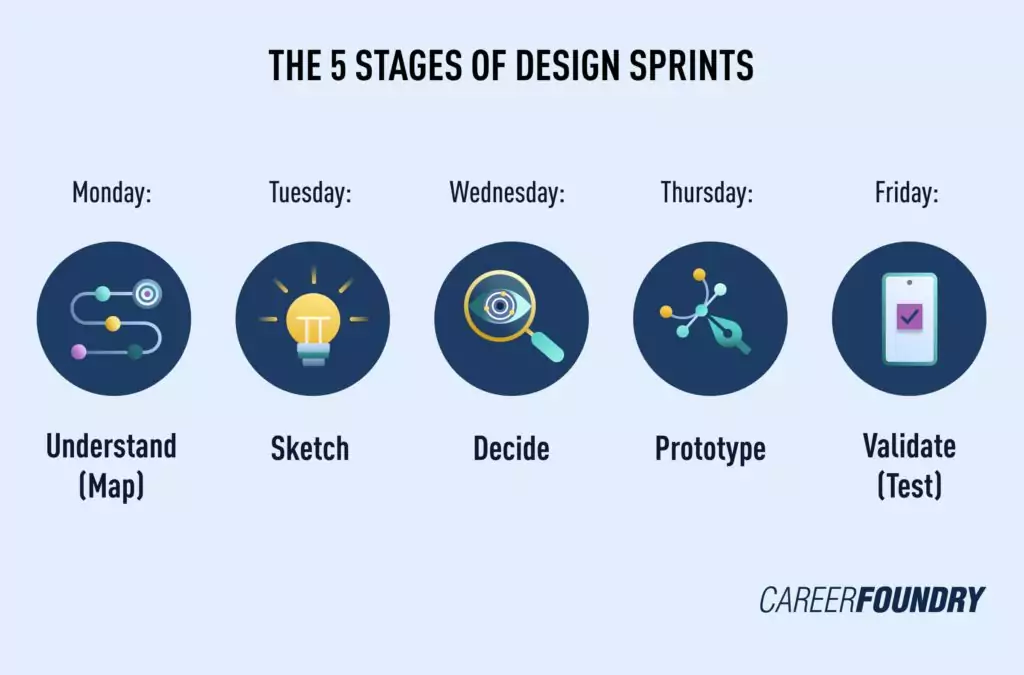If you’re involved in any aspect of product design, UX design, or marketing, you’ve likely heard the term “design sprints”.
Some of the leading companies worldwide, including Google, Uber, Slack, Meta, and the like, use sprints to solve their design challenges.
These days, more businesses are adopting some version of the design sprint for their own systems; and having some understanding of design sprints is almost a necessity in any business even loosely associated with design. You might find yourself participating in or even leading a sprint in the not-so-distant future!
In this article, we’ll look at what design sprints are and examine their context. Then we’ll dive into their five-day structure, and talk about the pros and cons of design sprints as a process. Finally, we’ll wrap things up with some key takeaways.
To skip ahead to any section, use this clickable menu:
- What are design sprints?
- Where and why were design sprints developed?
- The 5 stages of design sprints
- Design sprints pros and cons
- Design sprints and UX design
- How do remote design sprints work?
- Takeaways
What are design sprints?
A design sprint is an intense, structured, five-day process where product and development teams work together to solve design problems and answer critical business questions.
They’re a framework, used by companies globally, and global companies. Design sprints are a tried and tested process, with business strategy, innovation, behavior science, design thinking, and more included in any given sprint.
They pull together collaboration, ideation, prototyping, and testing into an accelerated process that produces fast answers to crucial product and business questions.
A design sprint will typically involve 4-7 people. Led by a facilitator, this group can include one of the company’s chief decision makers (often a CEO for startups), a product manager, a designer, an engineer, and someone from one of the company’s core business departments—such as content, marketing, or operations.
Where and why were design sprints created?
Design sprints were first created in 2013 at GV (formerly known as Google Ventures), the venture capital investment arm of Alphabet Inc.
Their goal was to develop an effective framework to answer critical business questions—most often how customers would react to a potential product—without having to make huge financial and time investments in product development.
They wanted to be able to quickly create many (or at least several) potential solutions, assess them, select the best one for prototyping, and test what customer reaction was likely to be. All without investing hundreds of thousands—or millions—of dollars, and wasting a lot of time.
GV themselves describe sprints as giving you a superpower: “You can fast-forward into the future to see your finished product and customer reactions, before making any expensive commitments.”
This graphic from the GV homepage neatly encapsulates the “superpower” that design sprints offer: the ability to generate key learnings about an idea without going through the costly and time-consuming building and launching phases:

Now let’s run through how each of the five days in the process is used.
The 5 stages of design sprints
Before beginning, the stage needs to be set for a successful sprint. This means identifying the challenge you face, assembling the right team to tackle it, and finding the appropriate time and space to hold the event.
Design sprints are tightly structured to a five-day schedule, with each day serving a distinct purpose.
Sticking to this schedule means the team can bypass time-consuming debate cycles that often bog down corporate decision-making and condense months of work into a single week.
This system allows teams to gather clear data from realistic prototypes and offer insight into a potential product’s value without having to go through the expensive commitment of a full launch.
Below is a typical five-day plan for a design sprint:
Monday: Understand (Map)
Map out the problem and goal and pick an important place to focus.
Tuesday: Sketch
Sketch competing solutions on paper.
Wednesday: Decide
Critique the ideas, make difficult decisions, and turn your ideas into testable hypotheses.
Thursday: Prototype
Hammer out a high-fidelity prototype.
Friday: Validate (Test)
Test it with at least five real users.

Design sprints pros and cons
In theory, design sprints allow you to accelerate insight—as mentioned, offering businesses a look at finished products and customer reactions without the usual financial expense and time loss.
But, they don’t always go to plan. Here are some key pros and cons to keep in mind when setting up your sprint:
Pros
- Design sprints break the cycle of over-analysis.
- They ensure your team doesn’t get bogged down in drawn-out debates and “death by committee”, the slow death of an idea, initiative, or project from the effects of the bureaucratic process.
- Dynamic, intense collaboration among team members is fostered by the design sprint format.
- The roll-out helps you develop a stronger understanding of important users.
- A sprint helps to get everyone on the same page to clearly define the required final deliverables.
- The environment stimulates the creativity and experimentation required to explore a wider range of ideas than normal.
- By creating several solutions that can be prototyped and tested you avoid having to put together in-depth specifications.
- Limits the time and financial costs of failure of the final deliverables in user testing.
- Because it requires active collaboration, a sprint creates a heightened sense of satisfaction and mutual ownership.
- Sprints let you gain a better understanding of the user experience, as you engage with user testing directly and watch as real users validate or invalidate ideas.
Cons
- The very speedy nature of design sprints can reduce their effectiveness in obtaining refined user research.
- Traditional, long-form research techniques can uncover deeper insights and more sophisticated results than design sprints.
- It can be argued that design sprints don’t offer definitive answers to problems—rather, they can help us to understand which plans to avoid, and where to go next.
- While design sprints are good at flagging negative results, they don’t always give us a clear, detailed picture of the solution.
- The drawing involved in sprint exercises can prove a barrier for some participants; not everyone is confident with sketching things out on paper, and the sprint leader’s job is to make everyone involved feel at ease with jotting things down.
- Critics of design sprints point out that the ideas behind them are things we’ve all encountered before.
- There is an argument that sprints don’t bring new techniques to the table; rather, they comprise a fast-paced amalgamation of typical best practices—usability testing, speedy prototypes, group brainstorming, and so on.
Now that we’ve covered the pros and cons of design sprints, we’ll quickly talk about how they can be applied to UX.
Design sprints and UX design
UX professionals worldwide have found design sprints to be an effective system to ensure they get the best results.
UX designers take up a core role in a design sprint, like any other type of designer would.
UX is about creating value for users, and it’s important for UX designers to bang this particular drum during a design sprint. Have the ideas been tested and validated? Are they based on company design standards? Are they technically feasible? As the UX pro in the room, it’s up to the UX designer to add UX-related requirements to any of the proposed ideas.
On a fundamental level, UX design skills, and experience in sketching out product wireframes, prove an asset to the team during the schematic workshops on day two of the sprint.
Although UX designers are used to working iteratively—gradually improving on a design by repeatedly cycling through a set of steps—rather than the accelerated, incremental workflow of a design sprint, sprints have proven to be incredibly beneficial to UX design, with companies like Google using them excellent effect.
Next, let’s explore remote design sprints—a topic that’s becoming increasingly relevant as the number of fully remote or remote-first companies continues to grow.

How do remote design sprints work?
Design sprints can be and often are, run remotely. Of course, this requires some additional considerations, which we’ll run through here.
But, before organizing your first design sprint, remote or otherwise, you might be interested in reading the authority on such topics, Sprint by GV’s Jake Knapp. Knapp shares a huge amount of valuable advice, centered on three areas: preparation, focus, and momentum.
Here’s how these work with a remote sprint:
Preparation
Knapp emphasizes that planning and preparation are crucial to organizing remote sprints. Map out your schedule, and decide on the tools you’ll need for each activity—real-time communication, asynchronous communication, virtual whiteboarding, storyboarding, and prototyping.
Use a universal meeting code for the duration of the sprint, to allow participants to jump in and out easily.
Rather than post-it notes, sharpies, and sketch pads, the materials you’ll need to prep will be digital murals or artboards, with sections for each activity.
This all changes on day two, when team members will have to equip themselves with pen and paper. Remind them to do so!
Focus
Whereas in-person sprints are device-free zones, there’s no escaping tablets and smartphones in a remote sprint. For this reason, it’s important to encourage your team to focus all their attention on the sprint when it’s in progress.
Having webcams and microphones on is a must. It’s tough replicating the intimacy of an in-person sprint, so seeing everyone engage is crucial. Even a muted microphone symbol can break the teamwork spell.
All this intense focusing will sap the group’s energy, meaning generous breaks are essential so that everyone can recharge and bring their best ideas to the sessions.
Momentum
A team retro is necessary after a remote sprint. What worked? What would you change next time? This information is very valuable, so talk it over with your team.
Next up, polish the ideas refined during your sprint, as you work towards a buildable solution.
Now we’ve covered the in and outs of running a remote design sprint, let’s wrap things up with a few key thoughts.
Takeaways
Design sprints follow a tight schedule that makes the most of the five days—allocating each a distinct purpose as part of a logical, structured process.
They need a well-prepared leader to be successful, one who can create a positive and energetic environment, but also keep a close eye on the clock.
After the design sprint is wrapped up, its success or failure can also hinge on the buy-in from the ultimate decision-maker. Getting their buy-in before the sprint is vital.
Design sprints can be an extremely useful process for quickly and (relatively) cheaply understanding a problem, designing and evaluating potential solutions, and getting immediate customer feedback on prototypes.
However, it’s important to remember that sprints aren’t a miracle cure for time-consuming, expensive product design. When the sprint is over, chances are a fair amount of legwork remains. Be it u-turns, polishing, or… another sprint.
If you’re interested in learning about how sprints work within design thinking, check out this video overview:
And if you’d like to find out more about UX, be sure to check out our free online introductory course.
Finally, if you want to read more about the intersection between design, UX, and sprint methodologies, you might be interested in these articles.

